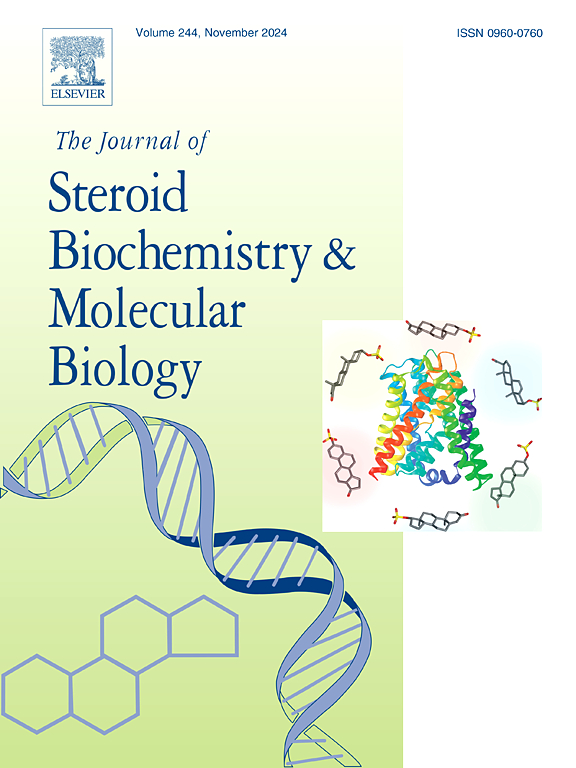An in-silico investigation of protein–ligand interactions involving dietary flavonoids targeting the nucleotide-binding domain 1 (NBD1) of multidrug resistance-associated protein 1 (MRP1) to overcome multidrug resistance in cancer
IF 2.5
2区 生物学
Q3 BIOCHEMISTRY & MOLECULAR BIOLOGY
Journal of Steroid Biochemistry and Molecular Biology
Pub Date : 2025-07-07
DOI:10.1016/j.jsbmb.2025.106832
引用次数: 0
Abstract
Multidrug resistance (MDR) continues to pose a tough challenge in the successful chemotherapeutic management of various malignancies. A key contributor to MDR is the multidrug resistance-associated protein 1 (MRP1), a member of the ATP-binding cassette (ABC) transporter family comprising 1531 amino acids. MRP1 actively extrudes a broad spectrum of chemotherapeutic agents from cancer cells, thereby reducing their intracellular accumulation and attenuating their cytotoxic effects. In this study, we performed molecular docking analyses to investigate the binding interactions between a series of naturally occurring dietary flavonoids and the Nucleotide Binding Domain 1 (NBD1) of MRP1, aiming to identify structural determinants that enhance ligand affinity and inform the selection of effective MDR modulators. All docking simulations were conducted using the Glide v5.7 software suite (Schrödinger LLC., Portland, USA) in extra precision mode (GlideXP). The 14 naturally occuring flavonoids assessed, rutin, taxifolin, myricetin, isorhamnetin, apigenin, eriodictyol, chrysin, daidzein and genistein exhibited variable binding affinities toward MRP1-NBD1, with several compounds forming key hydrogen bonds with active site amino acid residues. Notably, rutin demonstrated the highest binding affinity (docking score: –10.1958), forming highly stable hydrogen bonds with SER686 and SER689. Taxifolin and myricetin also showed favorable interactions, primarily involving SER686. These findings highlight the potential of specific dietary flavonoids to serve as functional inhibitors of MRP1-mediated drug efflux. Overall, the structural insights gained underscore the utility of flavonoid based scaffolds as promising candidates for overcoming MDR, thereby improving the therapeutic efficacy of anticancer agents.
一项针对多药耐药相关蛋白1 (MRP1)核苷酸结合结构域1 (NBD1)的膳食黄酮类化合物的蛋白质-配体相互作用的计算机研究,以克服癌症的多药耐药
多药耐药(MDR)继续对各种恶性肿瘤的成功化疗提出了严峻的挑战。多药耐药的一个关键因素是多药耐药相关蛋白1 (MRP1),它是由1531个氨基酸组成的atp结合盒(ABC)转运蛋白家族的一员。MRP1积极地从癌细胞中挤出广谱的化疗药物,从而减少它们在细胞内的积累并减弱它们的细胞毒性作用。在这项研究中,我们进行了分子对接分析,研究了一系列天然存在的膳食黄酮类化合物与MRP1核苷酸结合域1 (NBD1)之间的结合相互作用,旨在确定增强配体亲和力的结构决定因素,并为选择有效的MDR调节剂提供信息。所有的对接模拟都是使用Glide v5.7软件套件(Schrödinger LLC., Portland, USA)在超精确模式(GlideXP)下进行的。被测的14种天然黄酮类化合物,芦丁、紫杉醇、杨梅素、异鼠李素、芹菜素、叶黄醇、菊花素、大豆苷元和染料木素与MRP1-NBD1的结合亲和力不同,其中一些化合物与活性位点氨基酸残基形成关键氢键。值得注意的是,芦丁具有最高的结合亲和力(对接分数:-10.1958),与SER686和SER689形成高度稳定的氢键。Taxifolin和杨梅素也表现出良好的相互作用,主要涉及SER686。这些发现强调了特定膳食类黄酮作为mrp1介导的药物外排的功能抑制剂的潜力。总的来说,这些结构上的见解强调了类黄酮支架作为克服耐多药的有希望的候选者的效用,从而提高了抗癌药物的治疗效果。
本文章由计算机程序翻译,如有差异,请以英文原文为准。
求助全文
约1分钟内获得全文
求助全文
来源期刊
CiteScore
8.60
自引率
2.40%
发文量
113
审稿时长
46 days
期刊介绍:
The Journal of Steroid Biochemistry and Molecular Biology is devoted to new experimental and theoretical developments in areas related to steroids including vitamin D, lipids and their metabolomics. The Journal publishes a variety of contributions, including original articles, general and focused reviews, and rapid communications (brief articles of particular interest and clear novelty). Selected cutting-edge topics will be addressed in Special Issues managed by Guest Editors. Special Issues will contain both commissioned reviews and original research papers to provide comprehensive coverage of specific topics, and all submissions will undergo rigorous peer-review prior to publication.

 求助内容:
求助内容: 应助结果提醒方式:
应助结果提醒方式:


